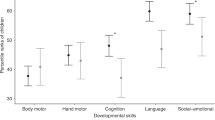Abstract
Pervasive media environment is a social problem shared by most of the countries around the world. Several studies have been performed to highlight the undesired effects of media on children. Some of these studies have focused on the time spent by children watching television, playing with computers or using mobile media devices while some others have tried to explain the associations between the obesity, postural abnormalities or psychological problems of children, and their media use. This article discusses the recent approaches to curb influence of media on children, and the importance of family media literacy education programs with particular relevance to developing countries.
Similar content being viewed by others
References
Jordan AB, Hersey JC, McDivitt JA, Heitzler CD. Reducing children’s television-viewing time: A qualitative study of parents and their children. Pediatrics. 2006;118:1303–10.
Yýlmaz G. The effects of media on child health. Turk Arch Pediatr. 2007;42:1–5.
Diamond MC. Plasticity of the Brain: Enrichment vs. Impoverishment. In: Clark C and King K, editors. Television and the Preparation of the Mind for Learning. Washington, DC: U.S.Department of Health and Human services. 1992.p. 8–19.
Schouten AP, Valkenburg PM, Peter J. Precursors and underlying processes of adolescents online selfdisclosure: developing and testing an “Internet-Attribute Perception” model. Media Psychol. 2007;10:292–315.
Beger G, Sinha A. South African Mobile Generation. Study on South African Young People on Mobiles, UNICEF 2012. Available from: http://www.unicef.org/southafrica/SAF_resources_MXitstudy.pdf. Accessed April 1, 2015.
Gupta R, Rasania KS, Acharya AS. The influence of television on urban adolescents of Delhi. Indian J Community Med. 2014;39:47–8.
Burdette HL, Whitaker RC, Kahn RS, Harvey BJ. Association of maternal obesity and depressive symptoms with television-viewing time in low-income preschool children. Arch Pediatr Adolesc Med. 2003;157:894–9.
Beresin EV. The impact of media violence on children and adolescents: opportunities for clinical interventions. American Academy of Child and Adolescent Psychiatry. https://www.aacap.org/AACAP/Medical_Students_and_Residents/Mentorship_Matters/DevelopMentor/The_Impact_of_Media_Violence_on_Children_and_Adolescents_OpportunitiesforClinical Interventions.aspx. Accessed April 1, 2014.
Bishwalata R, Singh AB, Singh AJ, Devi LU, Singh RK. Overweight and obesity among schoolchildren in Munipur, India. Natl Med J India. 2010;23:263–6.
Goyal JP, Kumar N, Parmar I, Shah VB, Patel B. Determinants of overweight and obesity in affluent adolescent in Surat city, South Gujarat region, India. Indian J Community Med. 2011;36:296–300.
Dietz WH. Overweight in childhood and adolescence. N Engl J Med. 2004;350:855–7.
American Academy of Pediatrics, Committee on Communications. Children, Adolescents, and Television (RE0043). Pediatrics. 2001;107:423–6.
Canadian Pediatric Society. Healthy active living for children and youth. Pediatric Child Health. 2002;7:339–45.
Costa SM, Horta PM, Santos LC. Analysis of television food advertising on children’s programming on “free-toair” broadcast stations in Brazil. Rev Bras Epidemiol. 2013;16:976–83.
Yousef S, Eapen V, Zoubeidi T, Mabrouk A. Behavioral correlation with television watching and video game playing among children in the United Arab Emirates. Int J Psychiatry Clin Pract. 2014;18:203–7.
Hinkley T, Verbestel V, Ahrens W, Lissner L, Molnar D, Moreno LA, et al. Early childhood electronic media use as a predictor of poorer well-being: a prospective cohort study. JAMA Pediatr. 2014;168:485–92.
Williams CL, Hayman LL, Daniels SR, Robinson TN, Steinberger J, Paridon S, et al. Cardiovascular health in childhood. J Circulation. 2002;106:143–60.
Drzal GJ, Snela S, Rykala J, Podgorska J, Rachwal M. Effects of the sitting position on the body posture of children aged 11 to 13 years. Work. 2014;6:1–8.
Wood B, Rea SM, Plitnick B, Figueiro GM. Light level and duration of exposure determine the impact of selfluminous tablets on melatonin suppression. Applied Ergonomics J. 2013;44:237–40.
DeGaetano G. Raising Media Literate Children. Parent Coaching Institute Articles and Research, 2007. Available from: http://www.thepci.org/articles/degaetano_MediaLiterateChildren.html. Accessed January 20, 2015.
Roberts DF, Foehr UG, Rideout V. Generation M. Media in the lives of 8–18 years olds. Menlo Park, Calif.: Keiser Family Foundation Study. 2005:41–55.
Author information
Authors and Affiliations
Corresponding author
Rights and permissions
About this article
Cite this article
Karaagac, A.T. Undesirable effects of media on children: Why limitation is necessary?. Indian Pediatr 52, 469–471 (2015). https://doi.org/10.1007/s13312-015-0657-3
Published:
Issue Date:
DOI: https://doi.org/10.1007/s13312-015-0657-3




